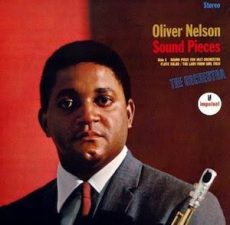
Requisites
Sound Pieces ~ Oliver Nelson | By Eddie Carter
My next record from the library is by Oliver Nelson, one of jazz’s finest arrangers, composers, and multi-instrumentalists, which is too good to leave sitting on the shelf. Few performances on LP ever reached the heights of his 1961 release, The Blues and The Abstract Truth, producing his biggest hit, Stolen Moments. Sound Pieces (Impulse A-9129/AS-9129) is one that did, and in the process, became one of the best albums in Nelson’s discography. What sets Sound Pieces apart is its unique combination of a large ensemble for three works of orchestral jazz on Side One and a quartet in a more intimate setting on Side Two. My copy is the original 1966 US Stereo release.
The personnel on this date are an all-star ensemble. John Audino (tracks: A1 to A3), Bobby Bryant (A1), Conte Candoli, Oliver Mitchell (A1 to A3), Al Porcino (A2, A3) on trumpet; Bill Byers (A2, A3), Dick Noel (A1), Ernie Tack (A1 to A3) on trombone; Red Callender (A2, A3) on tuba; Bill Hinshaw, Richard Perissi (A1 to A3) on French horn; Gabriel Baltazar Jr. and Bill Green (A1 to A3) on alto sax; Plas Johnson, Bill Perkins (A1 to A3) on tenor sax; Jack Nimitz (A1 to A3) on baritone sax; Oliver Nelson (A1 to B3) on soprano sax; Gabriel Baltazar Jr., Bill Perkins (A2, A3) on clarinet; Steve Kuhn (B1 to B3), Mike Melvoin (A2, A3) on piano; Ray Brown (A2, A3), Ron Carter (B1 to B3) on bass; Shelly Manne (A2, A3), Grady Tate (B1 to B3) on drums.
Sound Piece For Jazz Orchestra is an unforgettable story of music told in two main themes: the first one is a calm state of tranquility. The second is a searing portrayal originally written for The Stuttgart Radio Dance Band in 1963. The song opens with the bass clarinets sounding a commanding call and an exceptional utilization of brass and winds to announce the majestic chorus with strong statements. Originally written for alto saxophone, Oliver is featured on soprano sax and is the song’s only soloist in both sections. When the pace slows down to a softer tempo, he delivers a thoughtfully sensitive interpretation, caressing each phrase with the clarinets and horns discreetly in the background, culminating in a tender finale. The rhythm section shifts the song back to uptempo for the orchestra to restate the melody, stepping aside for Nelson, who gives an intense workout on the closer before the stunning finale.
Flute Salad is an original by Oliver Nelson that, as the title suggests, places the flutes in front, leading the orchestra in the animated opening and ending melodies. Conte Candoli is the featured soloist, and his muted horn delivers an air of assurance that flows sonorously with the brass section in support. The Lady From Girl Talk by Oliver was written for Actress Virginia Graham, who hosted Girl Talk, a syndicated program using this tune as her theme. The trombones announce the introduction before evolving into the orchestra’s full-bodied melody. Mike Melvoin begins a taut opening solo of rhythmic joy, illustrating his nimble hands at work. Oliver follows, his soprano moving gracefully with soulful precision on the closer for a compelling reading that is especially impressive.
The Shadow of Your Smile by Johnny Mandel and Paul Francis Webster is also known as Love Theme From The Sandpiper. Steve, Ron, and Grady join Oliver in presenting a Bossa Nova version, opening with the introduction as if the quartet is playing the standard at a slow tempo. The mood moves upward to a medium beat for the melody with an energetic swing led by Nelson. Steve charges the opening statement with mild energy and agile phrases, exhibiting the cohesive harmony between himself, Carter, and Tate. Oliver closes with an affectionate performance of deep emotion, rich harmony, and warm phrasing that, to these ears, captures the essence of expressing the love the lyrics depict.
Patterns is an uptempo original that first appeared in Oliver’s 1966 Book, Patterns For Improvisation (Jamey Abersold), a collection of improvisational jazz patterns in various meters and feels that spells out some of the basic building blocks of the jazz language. It is the most adventurous and interesting tune on the album, beginning with a thematic statement that the quartet takes as far as it will go. The opening solo by Nelson is well-developed. Kuhn heightens the mood by supplying a scintillating closing presentation, held firmly by the always energetic foundation of Carter and Tate into the quartet’s reprise and climax.
The final track is Oliver’s Elegy For a Duck, which he recorded earlier in the year on Peter and The Wolf with organist Jimmy Smith. Based on the original work by Russian composer, conductor and pianist Sergei Prokofiev, Ron and Grady establish the introduction with a bouncy beat that is maintained throughout the entire song. Oliver and Steve join them for a bit of relaxed spontaneity on the theme. Then, the saxophonist settles in for a beautifully articulated opening statement that is brisk and merry. Kuhn closes with a refreshing performance of intriguing ideas, subtle moods, and impressions on each chorus, which is a deft musical portrayal.
The East Coast orchestra tunes were recorded by Bob Simpson of RCA Studios in New York, and the man behind the dials in the West Coast quartet sessions was Jim Lockert of Western Recorders. I was extremely impressed with each man’s work on Sound Pieces, and the sound quality is spectacular on both sides of the album. It is especially impressive during the orchestra tracks; Lockert accurately captures the brass, reeds, and drums and is as close to the real thing as I have heard. The highs are clear, the character of each instrument at midrange is crisp and natural, and there’s ample response in the bass region.
Oliver Nelson recorded six small group albums for Prestige, playing the alto and tenor sax, and nine more albums for Impulse, affirming his inspired leadership. He scored background music for films and television shows after moving to the West Coast in 1967. Oliver also recorded several excellent orchestra albums, including Afro-American Sketches in 1962 and Full Nelson in 1963, which are two of his finest LPs alongside The Blues and The Abstract Truth. He also arranged and produced records for some of the elite pop stars during the latter half of the sixties. It is no wonder why the Jazz and Pop communities mourned him deeply after his death from a heart attack at the age of forty-three on October 28, 1975!
I was fourteen when I first heard this album; it made quite an impression on me then, and I still find something new in the music each time I listen to it now. Impulse LPs also set a high standard for their releases with laminated gatefold covers, a distinctive spine color, incredible photography, knowledgeable liner notes, and great music. Sound Pieces is a tour-de-force of brilliant arrangements, incredible artistry, superb writing, and unparalleled listening pleasure by Oliver Nelson. A remarkable talent who, whether on record or in concert, always gave jazz fans exciting performances and albums that are still considered a must-have for any library!
~ Patterns For Improvisation – Source: Amazon.com
~ Afro-American Sketches (Prestige PRLP 7225/PRST 7225); Full Nelson (Verve Records V-8508/V6-8508); Peter and The Wolf (Verve Records V-8652/V6-8652); The Blues and The Abstract Truth (Impulse! A-5/AS-5); Bob Simpson, RCA Studios, Jim Lockert, Western Recorders – Source: Discogs.com
~ Sound Piece For Jazz Orchestra, The Stuttgart Radio Dance Band, Flute Salad, The Lady From Girl Talk, Patterns, Elegy For a Duck – Source: Album liner notes by Nat Hentoff
~ Girl Talk, Virginia Graham – Source: IMDB.com
~ Sergei Prokofiev – Source: Wikipedia.org
© 2024 by Edward Thomas Carter
More Posts: choice,classic,collectible,collector,history,instrumental,jazz,music,saxophone
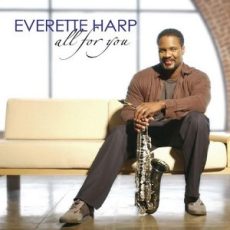
Daily Dose Of Jazz…
Everette Harp was born August 17, 1961 in Houston, Texas and was the youngest of eight children. His mother played the organ and gospel music was one of his earliest influences. He started playing jazz in middle school at Marshall Junior High under the tutelage of drummer Buddy Smith. He attended the High School for Performing and Visual Arts in Houston, then North Texas State University as a music major in the early 1980s.
He worked as an accountant for a short time, and played in local bands, most notably a jazz/funk group called The Franchise which released a 1987 album locally with the first recording of Harp’s There’s Still Hope. 1988 saw him moving to Los Angeles, California and touring briefly with Teena Marie, then Anita Baker.
Two years later George Duke signed him to a contract with Capitol Records to record with his group 101 North. Bruce Lundvall of Blue Note Records signed Harp to a solo contract before the group album was released. Harp’s album was produced by Duke and released by Blue Note in 1992.
Harp appeared at the Montreux Jazz Festival, would go on to appear on The Arsenio Hall Show, on Sax by the Fire, and perform on the theme songs for Entertainment Tonight and Soul Train and shared the stage with President Bill Clinton at the Arkansas Ball in 1992.
Harp has worked with Stanley Clarke, Natalie Cole, Neil Diamond, Aretha Franklin, Wayne Henderson, Al Jarreau, The Jazz Crusaders, Billy Joel, Chaka Khan, Kenny Loggins, Bobby Lyle, Peter Maffay, Marcus Miller, Chante Moore, Dianne Reeves, Eros Ramazzotti, Brenda Russell, Joe Sample, and Luther Vandross.
Saxophonist Everette Harp, who received his first nomination in 2015 for a Grammy Award for Best Contemporary Instrumental Album, continues to perform, compose and record.
More Posts: bandleader,composer,history,instrumental,jazz,music,saxophone
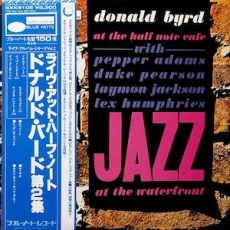
Requisites
Donald Byrd at The Half Note Café, Volume 2 | By Eddie Carter
I enjoyed listening to the first set of Donald Byrd at The Half Note Café so much that I decided to hear the second set as well, which inspired this morning’s discussion. So, as the quintet makes their way back to the stage, let’s all sit back in our seats to enjoy Donald Byrd at The Half Note Café, Volume 2 (Blue Note BLP 4061/BST 84061). Donald Byrd is on trumpet, Pepper Adams is on baritone sax, Duke Pearson is on piano, Laymon Jackson is on bass, and Lex Humphries is on the drums. My copy is the King Record Company Japanese Stereo reissue (Blue Note BST 84061 – GYK-8105).
The rhythm section lays the foundation to begin Jeannine by Duke Pearson with their introduction ahead of the front line’s opening chorus. Donald lights the first solo like a shining beacon. Pepper succeeds him with a briskly exciting performance; then Duke keeps your foot tapping with swinging precision ahead of the ensemble’s closing chorus and trio ending softly. The leader then introduces the group’s theme, Pure D. Funk, before leading the trio through the bluesy theme. Pepper is up first with a relaxing interpretation. Duke has a very fine spot next, and then Donald is as smooth as Tennessee Whiskey preceding the group’s reprise and climax.
Side Two starts with Lex’s percussive introduction to the quintet’s medium melody of Donald’s second tune, Kimyas. Pepper swings easily in an impressive opening statement. Donald follows with another equally blissful gem. Duke completes the solos at a leisurely pace anchored by Laymon and Lex until the quintet’s ending theme. When Sonny Gets Blue by Marvin Fisher and Jack Segal opens with the front line delivering a very pretty opening chorus. Duke gets the song’s only solo and delivers a wonderful expression of incredible beauty and solace, leading to the quintet’s theme restatement. Donald ends the evening by thanking the crowd for being a receptive audience.
Alfred Lion produced this live date, and Rudy Van Gelder was the recording engineer. The sound quality possesses a top-notch soundstage that truly makes you feel like you’re right there in the Half Note Café audience. King Record Company has beautifully remastered the original mono tapes, enhancing the experience. If you’re new to the music of Donald Byrd or only know of his later ’70s jazz-funk releases, I invite you to check out Donald Byrd at The Half Note Café, Volume 2, on your next record hunt. Like its companion, Volume 1, the musicians are wonderful. The music has stood the test of time and both albums are excellent documents of a live jazz performance the listener can revisit anytime!

More Posts: choice,classic,collectible,collector,history,instrumental,jazz,music,trumpet
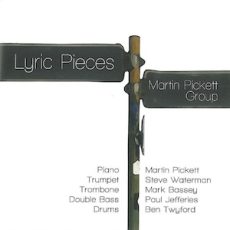
Daily Dose Of Jazz…
Martin Pickett was born on August 2, 1969 in Bristol, United Kingdom. His love of music took shape in his early teens, writing songs and playing guitar. He studied classical guitar through to Bristol University, while having piano as a second instrument and exploring compositional approaches.
After graduating Pickett received a Postgraduate Certificate in Education (PGCE) in secondary music education, then moved to Oxford, UK to teach music in a secondary school. It was during this period that his interest in jazz piano dominated his musical activities.
In 1998 Martin left his teaching post to work as a freelance jazz pianist and teacher. Since this time he has worked in a variety of settings and worked with a wide array of Britain’s most talented musicians.
He has recorded his own compact disc, I’ll Be With You Again in 2005 and played on albums by Diane Nalini, Tim Wilson, 3BPM, and Frank Hockney. He was featured as a composer on all of these apart from Frank’s project.
Pianist Martin Pickett has been a teacher in Oxford since 1998 and continues to focus his attention to being a freelance jazz pianist, performing with the group 3BPM, and songwriting collaboration with Tony Isaacs..
More Posts: bandleader,history,instrumental,jazz,music,piano,songwriter
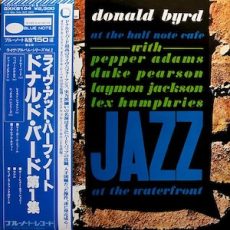
Requisites
Donald Byrd at The Half Note Café, Volume 1 | By Eddie Carter
I was still in the mood to hear another trumpet album after listening to Harry “Sweets” Edison when my search led me to another of my Mom’s favorite records. Donald Byrd and Pepper Adams were two musicians she enjoyed listening to and this morning’s record from the library brings them together in a great live date. Donald Byrd at The Half Note Café, Volume 1 (Blue Note BLP 4060/BST 84060) captures the trumpeter’s quintet featuring Pepper Adams (tracks: A1, A2, B2, B3) on baritone sax, Duke Pearson on piano, Laymon Jackson on bass and Lex Humphries on drums in performance at one of New York’s best jazz clubs. This album holds a special place in my heart because it reminds me of the music my Mom and I used to enjoy together during Sunday dinner. My copy is the 1978 King Record Company Japanese Stereo reissue (Blue Note BST 84060 – GXK-8104).
Ruth Mason is our Mistress of Ceremonies for the evening and starts the set with the musician’s introductions. The quintet then launches into the upbeat melody of My Girl Shirl by Duke Pearson. Donald kicks off the solos with an invigorating statement; then Pepper succeeds him with a joyfully spirited solo. Duke emerges next for a brisk presentation, and the front line cooks with Lex ahead of the close. Donald introduces the next tune, his own Soulful Kiddy, a blues that slows the beat down for the ensemble’s marching melody. Pepper serves up some down-home cooking in the opening solo. Donald comes into the second reading with carefree enthusiasm; then Duke eases into the spotlight last, leading to the theme’s restatement and climax.
Side Two opens with Donald’s introduction to A Portrait of Jennie by J. Russel Robinson and Gordon Burdge. The quartet showcase begins with the trumpeter’s romantically warm introduction to the melody. He continues mining a rich vein of sentimentality in the first solo. Duke takes over to deliver a very pretty reading until Donald’s return to add a few more comments into the reprise and close. Cecile by Donald Byrd brings the quintet back for a medium blues that commences with the trio’s introduction to the front line, taking the lead in the melody. Pepper takes off first, cruising at a comfortable pace. Donald gets to work next with an impressive interpretation, and then Duke completes the infectious beat in the finale ahead of the quintet’s closing moments.
The set climaxes with the group’s theme, Pure D. Funk. Donald has the showcase to himself in a concise theme and the song’s only solo into the ensemble’s conclusion. Alfred Lion produced Donald Byrd at The Half Note Café, Volume 1, and Rudy Van Gelder was behind the dials. The reissue has an excellent soundstage transporting the listener to the club audience with excellent fidelity. The unique sound of this album, with its stellar rhythm section and the great chemistry between Donald Byrd and Pepper Adams, is sure to captivate any jazz enthusiast. I invite you to pick up Donald Byrd at The Half Note Café, Volume 1, on your next record shopping trip. It’s a delightful live album that is sure to enjoy repeated plays on the turntable!
Postscript: For those who are unaware, Ruth Mason was a singer and WOV on-air personality who would become Mrs. Alfred Lion. She is also the lovely young woman who appears on the cover of Moods by The Three Sounds.
~ Moods (Blue Note BLP 4044/BST 84044) – Source: Discogs.com © 2024 by Edward Thomas CarterMore Posts: choice,classic,collectible,collector,history,instrumental,jazz,music,trumpet


